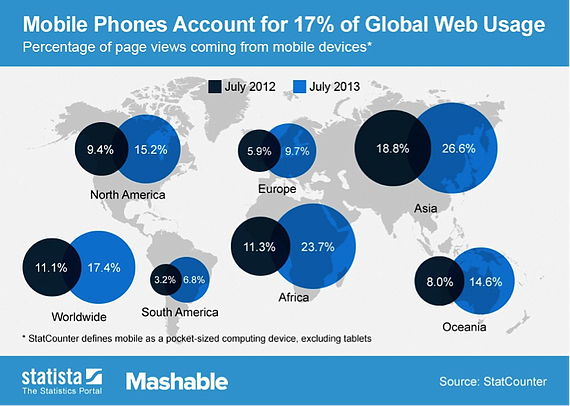 Your website is so much more than just a website (or at least it should be). In a fast-paced, consumer-driven, online world, your website has the power to make or break your bottom line. It’s likely the backbone of customer perception and it can be the catalyst for droves of new leads.
Your website is so much more than just a website (or at least it should be). In a fast-paced, consumer-driven, online world, your website has the power to make or break your bottom line. It’s likely the backbone of customer perception and it can be the catalyst for droves of new leads.
But if you’re not giving it the love and attention it deserves, your website can actually be sabotaging new sales. Read through this list of signs and make a note of any that apply to you. This post will give you a logical starting point for improving your website to help support your sales team.
1) It’s Not Mobile Friendly (i.e. Easy to View on a Mobile Device)
The days of asking if a mobile-friendly website really necessary are over. The answer is an emphatic, scream-it-from-the-rooftops, "YES." The world is mobile, to the tune of 6 billion users. According to the United Nations, only 4.5 billion of the world’s luckiest contestants have access to a working toilet, but out of the total global population of 7 billion, a resounding 86% of folks have access to a mobile phone. Not only do most people own a mobile device, they are increasingly using them to access the Internet.

According to the above graphic from Mashable, over 15% of North American Internet usage was on a mobile device in 2013. That jumped almost 6% from the previous year. Heck, in Asia, over 26% of people are using their mobile devices to find your website. The numbers don’t lie; if your website isn’t mobile-friendly, you are quite candidly losing out on GADS of potential customers.
2) You're Not Using Calls To Action
Calls to Action (aka CTAs) are buttons and banners that drive a website user to action. They give your website a purpose and guide visitors down an intended path, a path that you’ve cleverly maneuvered to capture leads and increase sales (gosh you’re a sly devil).
With one click, CTAs direct website visitors to a specific landing page designed to convert that visitor into a lead (or move them to another stage of the sales process). Imagine a user visits your Services page and is totally blown away by what you do and how you can help them. Wouldn’t you like to be in charge of that user’s next step? A CTA lets you do that. Instead of that user navigating away from the Services page to search for additional useful information (maybe it’s viewing testimonials, maybe it’s accessing pricing info), you can use a CTA to direct them.
For example, a CTA that says Request a Free Consultation or Contact a Certified Sales Consultant defines a user’s next course of action and increases the probability that he or she will follow the path you’ve defined through these strategically placed CTAs. Visitor to lead conversions and ultimately, lead to sale conversions, are the name of the game, and if you’re not placing a CTA on every single page to guide users, you are decreasing conversion odds. CTAs are a simple tactic with massive conversion payoff.
3) You Didn't Do Any SEO Research or Optimization
We probably should have made this #1 on the list, because this is huge. Effective website copy is a delicate and skillful game of cat and mouse. The words you choose and optimize your pages with help Google determine if your website lands on page one, page two, etc. in search results.
And, since a whopping 75% of Google searchers never look past page one, you need to do everything in your power to get there. Conducting a thorough SEO (search engine optimization) keyword analysis is a critically important step before writing website copy. Want to know if your site is in good shape? Ask yourself the following three questions:
- Have you analyzed your competitors’ keywords?
- Have you researched monthly search volume and difficulty score of your core offering keywords?
- Have you used your findings to better optimize your site copy?
If you answered "yes" to the above three questions, you get an A+ for this section and you can move on to #4. But if you answered "no" for any of them, please continue reading #3.
So why has SEO been pushed to the side? Maybe your website really hasn’t been top of mind for the last few months (years perhaps?)
Maybe you’re focused on other things (year-over-year revenue growth, paying salaries, hiring a new CIO, getting to the bottom of 3000 unread emails, etc.)
In the midst of your unavoidably fragmented focus, Google took over the world and SEO became a dominant and formidable force in the world of marketing. And while it may feel like this transition happened overnight, it’s actually been years in the making, and some, if not many of your competitors have likely hopped aboard the SEO train and have seen sales flourish in the process.
Good news folks, you haven’t missed the boat completely. SEO is very much a living, breathing, thriving marketing channel, and while it may take awhile to make up for lost ground, there's no better time than the present. Don't let your website's optimization (or lack thereof) hold you back from closing more sales-- optimize for search engines and get the right traffic funneling to your website.
4) Your Website Isn't Optimized for Buyer Personas
This ties closely to #3. After conducting an SEO analysis and determining the keywords that will help you land on page 1, it’s time to take your copy a step further. Every letter, every word of your website messaging is an opportunity to connect with your ideal buyer.
And just so we’re on the same page, an ideal buyer is simply your version of the ideal customer. Maybe it’s a woman over 40 who loves golf. Maybe it’s a C-level at a technology company with over $5 million a year in revenue. Identifying your ideal buyer persona and understanding that buyer’s distinct characteristics is the foundational step in creating copy that motivates conversions. Your entire organization should be able to concisely articulate just who your ideal buyer is and what matters to them. To start uncovering the type of content to serve up, ask yourself questions like:
- What matters to them?
- Why have they sought out your site?
- What problem are they trying to solve?
- How can you deliver a solution for their need?
If nothing else, your website copy should answer these questions. But please, for the love of Lead Conversions, don’t stop there. If you’ve done your SEO keyword homework, you know the good juicy words that matter to your ideal buyers.
Once these buyer personas are defined and the appropriate keywords are uncovered and included in your site's optimization, your website will be infinitely more effective in converting leads to sales. Why? If prospects feel like you relate to their pain, desires, and purpose, your website will be a living, breathing sales machine.
5) You're Ignoring Your Website's Analytics
Stop me if you've seen this before: you're viewing your site analytics platform and notice that your website visitors spend a significant amount of time browsing your website. They visit several pages, devote a solid amount of time to viewing each of those pages, but then exit the site without converting to a lead.
What. The. Heck.
Search Engines might as well say, “Congratulations on your super cool site, too bad it’s not doing a thing to get you sales”. See, it’s all about reading between the lines of those meaty analytics stats like bounce rate, unique page visits, first time vs. returning visitors, and conversion rate.
Website analytics tell a story that you can use to transform your site into a lead generating machine, so if you’re feeling less than excited about your story, it’s time to take a look at the analytics. They'll tell a story of why your visitors aren't converting to leads and subsequently, sales. So, uncover that story and figure out what you can do to fix it. In fact, I'm pretty confident a lot of tactics I mention in this post can help solve these shortcomings!
6) Your Website Has No Lead Generation Goals
Ok, I'm assuming you’ve set lead generation goals for your website (you have that, right?). If not, it's time to create them. Effective websites, that is, those designed with a solid SEO foundation tailored to your target persona with conversion opportunities have the innate ability to work around the clock to bring you leads. When your sales team punches the clock at 6pm, your website should still be prospecting, coverting, and nurturing leads.
Each member of your sales team has goals, and since your website will be feeding leads to the sales team, doesn't it make sense for your digital presence to have goals as well? Without a set metric of leads to attain through the website, your sales team might as well be flying blind. So, align your website's lead generation goals with the sales team. You'll be aligned and marketing will ultimately support sales. Sounds nice, yeah?
7) Your Sales Team Isn't Leveraging The Website
Did you read #6? Make sure you read #6 first!
Just like your website can be the company’s most effective salesperson, the website should also be one of your sales team’s most valuable assets. Every picture, word, lead generation form and section should be a leverageable asset that increases the efficacy of the sales team's efforts.
As we mentioned in #6, your website should drive leads that sales can close, and everyone in sales knows a warm lead beats a cold prospect any day of the week. Placing forms that capture information and convert visitors to leads on your website is one of the easiest ways sales can leverage your website for lead generation.
Entice visitors to fill out forms by offering a valuable piece of content or promotion. Sales can use this voluntarily submitted form information to prepare a relevant, value-add sales pitch or intro conversation that resonates with the prospect and lays the groundwork for a mutually beneficial relationship.
For all the useful sales sheets, doubled sided PDFs, PowerPoint decks and full-color brochures you’re probably using to help close sales, a good website utilizes them all in a number of ways. Consumers have come to expect that your website will be the go-to resource for everything your business can offer, so it’s in your best interest to capitalize on this behavior by gathering information that sales can strategically use to close new business.
The Bottom Line
We’d be willing to bet the farm that you can relate to at least one of these signs (and double or nothing says it’s more than one). Make 2014 your year to invest in transforming your website into a priceless asset that works to fill your pipeline, amplify sales and maximize ROI. Now that’s a New Year’s Resolution worth keeping!


